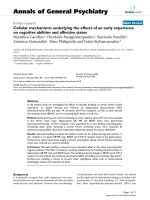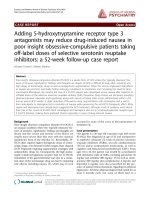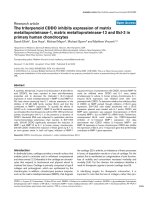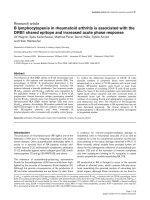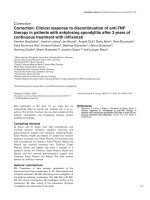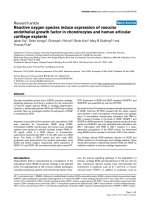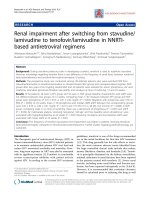Báo cáo y học: "Respiratory rehabilitation after acute exacerbation of COPD may reduce risk for readmission and mortality – a systematic review " ppt
Bạn đang xem bản rút gọn của tài liệu. Xem và tải ngay bản đầy đủ của tài liệu tại đây (366.16 KB, 12 trang )
BioMed Central
Page 1 of 12
(page number not for citation purposes)
Respiratory Research
Open Access
Research
Respiratory rehabilitation after acute exacerbation of COPD may
reduce risk for readmission and mortality – a systematic review
MiloAPuhan*
1
, Madlaina Scharplatz
1
, Thierry Troosters
2
and
Johann Steurer
1
Address:
1
Horten Centre, University of Zurich, Switzerland and
2
Respiratory Division, Respiratory Rehabilitation, and Faculty of Kinesiology and
Movement Sciences, Katholieke Universiteit Leuven, Leuven, Belgium
Email: Milo A Puhan* - ; Madlaina Scharplatz - ;
Thierry Troosters - ; Johann Steurer -
* Corresponding author
Abstract
Background: Acute exacerbations of chronic obstructive pulmonary disease (COPD) represent
a major burden for patients and health care systems. Respiratory rehabilitation may improve
prognosis in these patients by addressing relevant risk factors for exacerbations such as low
exercise capacity. To study whether respiratory rehabilitation after acute exacerbation improves
prognosis and health status compared to usual care, we quantified its effects using meta-analyses.
Methods: Systematic review of randomized controlled trials identified by searches in six electronic
databases, contacts with experts, hand-searches of bibliographies of included studies and
conference proceedings. We included randomized trials comparing the effect of respiratory
rehabilitation and usual care on hospital admissions, health-related quality of life (HRQL), exercise
capacity and mortality in COPD patients after acute exacerbation. Two reviewers independently
selected relevant studies, extracted the data and evaluated the study quality. We pooled the results
using fixed effects models where statistically significant heterogeneity (p ≤ 0.1) was absent.
Results: We identified six trials including 230 patients. Respiratory rehabilitation reduced the risk
for hospital admissions (pooled relative risk 0.26 [0.12–0.54]) and mortality (0.45 [0.22–0.91]).
Weighted mean differences on the Chronic Respiratory Questionnaire were 1.37 (95% CI 1.13–
1.61) for the fatigue domain, 1.36 (0.94–1.77) for emotional function and 1.88 (1.67–2.09) for
mastery. Weighted mean differences for the St. Georges Respiratory Questionnaire total score,
impacts and activities domains were -11.1 (95% CI -17.1 to -5.2), -17.1 (95% CI -23.6 to -10.7) and
-9.9 (95% CI -18.0 to -1.7). In all trials, rehabilitation improved exercise capacity (64–215 meters
in six-minute walk tests and weighted mean difference for shuttle walk test 81 meter, 95% CI 48–
115).
Conclusion: Evidence from six trials suggests that respiratory rehabilitation is effective in COPD
patients after acute exacerbation. Larger trials, however, are needed to further investigate the role
of respiratory rehabilitation after acute exacerbation and its potential to reduce costs caused by
COPD.
Published: 08 June 2005
Respiratory Research 2005, 6:54 doi:10.1186/1465-9921-6-54
Received: 17 February 2005
Accepted: 08 June 2005
This article is available from: />© 2005 Puhan et al; licensee BioMed Central Ltd.
This is an Open Access article distributed under the terms of the Creative Commons Attribution License ( />),
which permits unrestricted use, distribution, and reproduction in any medium, provided the original work is properly cited.
Respiratory Research 2005, 6:54 />Page 2 of 12
(page number not for citation purposes)
Introduction
Acute exacerbations of chronic obstructive pulmonary dis-
ease (COPD) represent a major burden for patients and
health care systems. For patients, acute exacerbations are
a common reason for hospital admissions and severely
affect health-related quality of life (HRQL) [1] and prog-
nosis[2]. Mortality rates during hospitalisations are
around 10% [3,4] and during the year following a hospi-
talisation may be as high as 40% [3,5].
From the health care provider's perspective, COPD is
resource consuming [6]. A small proportion of COPD
patients of around 10% suffering from acute exacerba-
tions accounts for over 70 percent of costs caused by
COPD because of emergency visits and hospitalisations
[6-8]. The readmission rate is typically high in these high-
risk patients. A recent large study found a readmission rate
of 63% during a mean follow-up of 1.1 year with physical
inactivity amongst the significant predictors for
readmissions[9].
Recent position papers of the American College of Physi-
cians and American College of Chest Physicians provided
recommendations on the management of acute exacerba-
tions [10,11]. However, a weakness of these papers was
that they did not provide recommendations how future
exacerbations and hospitalisations could be prevented
despite being one of the main goals of COPD manage-
ment [11,12]. One solution that has been adopted in clin-
ical practice is to provide rehabilitative care after
treatment of acute exacerbation including physical exer-
cise, patient education focusing on self-management strat-
egies and psychosocial support. The rationale to offer
rehabilitation in patients recently treated for acute exacer-
bation is to enhance HRQL as in stable COPD patients
[13], but also to modify factors associated with increased
risk for post-exacerbation morbidity and mortality. A
recent study showed that exacerbations results in acute
muscle deconditioning and weakness[14]. Hence patients
with frequent exacerbations have more pronounced skel-
etal muscle weakness and a more limited six minute walk-
ing distance [15], which is in turn a risk factor for
exacerbations and mortality [3,16].
Thus respiratory rehabilitation may have the potential to
reduce hospital admissions by improving exercise capac-
ity. It is hence surprising, and in contrast to the large body
of evidence supporting respiratory rehabilitation in stable
patients [13,17], that the effects of respiratory rehabilita-
tion in patients after acute exacerbation has never been
studied systematically. Therefore, our aim was to conduct
a systematic review of all randomized controlled trials
that compared respiratory rehabilitation after acute exac-
erbation and usual care.
Methods
Identification of studies
We used five strategies to identify studies including elec-
tronic databases, consultations with experts from North
America and Europe, our own files, bibliographies of arti-
cles that met the inclusion criteria and conference pro-
ceedings of the International Conference of the American
Thoracic Society and the Congress of the European Respi-
ratory Society.
An information specialist conducted electronic database
searches in MEDLINE (Ovid version, New York, New
York, from inception to April 2005), EMBASE (DataStar
version, Cary, North Carolina from inception to April
2005), PEDRO (online version, University of Sydney,
Australia, April 2005) and the Cochrane Central Register
of Controlled Trials (Oxford, United Kingdom, 2005,
Issue 1). We did not restrict the search to COPD patients
with exacerbation only because exacerbation is not
indexed as a Medical subject heading term and we feared
to miss relevant studies with a narrow search. We used a
broad search strategy using the terms "lung diseases
obstructive", "chronic obstructive lung disease", "chronic
obstructive pulmonary disease", "rehabilitation", "exer-
cise", "exercise movement techniques", "physical endur-
ance", "muscle training", "kinesiotherapy", "clinical
trial", "controlled study" and "epidemiologic methods". A
detailed search strategy is available on request. We also
searched the Science Citation Index database (Web of Sci-
ence, Thomson ISI, Philadelphia, Pennsylvania) and the
"related articles" function of PubMed (National Library of
Medicine, 8600 Rockville Pike, Bethesda, MD 20894) by
entering all included studies.
Inclusion criteria
We included randomized controlled trials comparing res-
piratory rehabilitation of any duration after acute exacer-
bation of COPD with conventional care. Respiratory
rehabilitation programmes needed to include at least
physical exercise. We included studies if more than 90%
of study participants had COPD. Main outcome measure
was unplanned hospital admissions and secondary out-
comes included exacerbations, outpatient visits, dyspnea,
HRQL as measured by disease-specific or generic ques-
tionnaires, functional and maximum exercise capacity,
mortality and adverse events during rehabilitation. We
did not apply any language restrictions.
Study selection
The bibliographic details of all retrieved articles were
stored in a Reference Manager file (Professional Edition
Version 10, ISI ResearchSoft, Berkeley, California). We
removed duplicate records resulting from the various
database searches. Two members of the review team
(MAP, MS) independently scrutinized the titles and
Respiratory Research 2005, 6:54 />Page 3 of 12
(page number not for citation purposes)
Study flow from identification to final inclusion of studiesFigure 1
Study flow from identification to final inclusion of studies.
Total citations identified from electronic databases (Medline, Embase, Pedro,
CENTRAL)
n=1759
All studies identified n=7
- From electronic databases n=4
- From hand searching n=3
Excluded after full text assessment
Reasons for exclusion:
-NoexacerbationofCOPD n=10
- Not randomised controlled trial n=3
- Control group without usual care n=1
- <90% COPD patients n=1
Total: n = 15
Citations excluded after screening titles and abstracts
n=1740
Studies retrieved for detailed evaluation:
- From electronic databases: n=19
- From hand searching (conference proceedings, reference lists of reviews and
identified studies, Science Citation Index and “related articles” function of
PubMed entering identified studies) : n=3
Total: n=22
Initial agreement on in-
and exclusion:
100%, κ=1.0
Respiratory Research 2005, 6:54 />Page 4 of 12
(page number not for citation purposes)
abstracts of all identified citations (see Figure 1) and
ordered the full text of any article that was deemed poten-
tially eligible by one of the reviewers. The two reviewers
evaluated the full text of all retrieved papers, made a deci-
sion on in- or exclusion and discussed the decisions. Any
disagreement was resolved by consensus with close atten-
tion to the inclusion/exclusion criteria. We recorded the
initial degree of discordance between the reviewers and
corrected discordant scores based on obvious errors. We
resolved discordant scores based on real differences in
interpretation through consensus or third party
arbitration.
Data extraction and quality assessment
We performed the data extraction using pilot-tested data
forms. One reviewer extracted details about study
patients, interventions and outcome measures as well as
the results in a predefined data form and the second
reviewer checked the data extraction for accuracy. We con-
tacted all authors of the primary studies to obtain missing
information. Two reviewers independently evaluated the
quality of included trials using a detailed list of quality
items assessing components of internal validity (Table 2)
[18]. We did not rate the two items "blinding of patients"
and "blinding of persons who implements intervention"
because patients and treatment providers cannot be
blinded in studies comparing respiratory rehabilitation
and usual care.
Methods of analysis and synthesis
We summarized the results of the data extraction and
assessment of study validity in structured tables. We
pooled trial results using fixed effects models if there was
no significant heterogeneity (p ≤ 0.1 with Q statistic for
continuous and Cochran chi-squared test for binary out-
comes). In anticipation of significant heterogeneity we
established a priori hypotheses to explain differences in
outcomes across studies. First, heterogeneity may arise
from the setting patients were recruited (in- or outpatient
treatment of exacerbation), second from different lengths
of follow-up, third from different length of the interven-
tion and finally from differences in the methodology of
the intervention. Pooled risk ratios and 95% confidence
intervals (CIs) were computed by calculating weighted
mean differences and pooled risk ratios using STATA (ver-
sion 8.2, Stata Corp., College Station, Texas).
Results
We show the study selection process and agreement on
study inclusion in Figure 1. Out of the 22 potentially rele-
vant articles, we included seven reports (Table 1). Two
articles were based on the same trial. One reported the
results after six [19] and the other one after 18 months
[20]. In five trials, patients were recruited after inpatient
care and in one trial [21] after hospital at home treatment
for acute exacerbation. Two trials reported on the short-
term benefit of inpatient rehabilitation programs [22,23]
and four trials had rehabilitation programs of six weeks to
six months duration [20,21,24,25]. One trial was pub-
lished as an abstract only [25], but additional information
was available from an earlier publication[26] and from
the author. Altogether 140 patients were randomized to
the rehabilitation intervention, and 90 were randomized
into respective control groups.
Initial agreement of reviewers on quality assessment was
85% for all items (chance corrected kappa = 0.70). All dis-
agreement could be resolved by consensus. The quality of
trials was moderate (Table 2). Three trials provided details
about the randomisation procedures and three trials
about concealment of random allocation, while in none
of the trials the outcome assessors were blinded.
Effect on hospital admissions
Figure 2 shows the effect of respiratory rehabilitation on
unplanned hospital admissions for each study [20,21,24]
and the pooled relative risk ratio of 0.26 (0.12–0.54). The
Table 2: Quality assessment
Study Prognostically
homogenous
study
population
Concealment
of random
allocation
Prestratification
on prognostically
relevant variables
Description of
randomisation
procedure
Registration
of loss to
follow-up
Registration of
co-interventions
for each group
Blinding of
outcome
assessors
Check
success of
blinding
Behnke [19, 20] +/- - - - + +/- - -
Kirsten 1998 [22] +/- - - - + +/- - -
Man 2004 [24] +/- + + +/- + - - -
Murphy 2005 [21] +/- + - - + - - -
Nava 1998 [23] +/- - - +/- + - - -
Troosters [25, 26] +/- + - - + - - -
+: Fulfilled; +/-: Partially fulfilled; -: Not fulfilled or no information provided
Respiratory Research 2005, 6:54 />Page 5 of 12
(page number not for citation purposes)
other trials included either only inpatients [22,23] or did
not record hospital admissions during the follow-up [25].
Effect on HRQL
Three trials assessed HRQL using the Chronic Respiratory
Questionnaire (CRQ) [20,24] and the St Georges Respira-
tory Questionnaire (SGRQ) [21,24] (Figure 3). With both
instruments, the trials found large effects exceeding the
minimal important difference of 0.5 on the CRQ and of 4
on the SGRQ. Weighted mean differences (expressed as
points change on a scale from 1 to 7) on the CRQ were
1.37 (95% CI 1.13–1.61) for the fatigue domain, 1.36
(0.94–1.77) for emotional function and 1.88 (1.67–2.09)
for mastery. Weighted mean differences for the SGRQ
total score, impacts and activities domains were -11.1
(95% CI -17.1 to -5.2), -17.1 (95% CI -23.6 to -10.7) and
-9.9 (95% CI -18.0 to -1.7). For the CRQ dyspnea and
SGRQ symptoms domain, results were too heterogeneous
to be pooled (Q = 6.44, p = 0.01 for CRQ dyspnea domain
and Q = 3.50, p = 0.06 for SGRQ symptoms domain), but
all studies showed a consistent effect in favor of the reha-
bilitation intervention.
Man and Murphy also used generic HRQL instruments
and found improvements by respiratory rehabilitation of
10.6 (-0.3 to 21.6) and 20.1 (3.3 to 36.8) on the physical
composite and mental composite score of the Short-Form
Survey 36 [24] and of 0.18 (95% CI 0.04 to 0.32) with the
EuroQol score [21].
Effect on dyspnea
In the trial by Behnke [20], the mean difference between
groups on the transition dyspnea index was 6.9 (3.9 to
9.9) at the end of the treatment period and 8.6 (6.3–10.9)
after 18 months. Kirsten[22] found significant differences
in Transition dyspnea index scores after a short inpatient
rehabilitation (p < 0.05, no additional data available) and
Nava [23] also observed a significant effect of rehabilita-
tion on dyspnoea (difference between groups 17 mm on
visual analogue scale after a 50 meter walk, p < 0.01).
Murphy [21] used the Medical Research Council dyspnea
scale and also found that respiratory rehabilitation
decreased dyspnea by 0.3 although this did not reach sta-
tistical significance (95% CI -0.92 to 0.32).
Effect of respiratory rehabilitation on unplanned hospital admissionsFigure 2
Effect of respiratory rehabilitation on unplanned hospital admissions. Boxes with 95% confidence intervals represent point esti-
mates for the risk ratio.
Study
(n rehabilitation/
usual care group)
Man (20/21)
Behnke (14/12)
Length of
follow-up
18 months
3 months
Risk of unplanned
hospital admission
Favors usual careFavors rehabilitation
Risk ratio (95% CI)
Overall (47/46)
.25 .5 .75 1 1.5
0.29 (0.10 to 0.82)
0.17 (0.04 to 0.69)
0.40 (0.09 to 1.70)
0.26 (0.12 to 0.54)
Chi-Squared 0.70, p=0.71
Murphy (13/13) 6 months
Weight in %
37%
44%
19%
Respiratory Research 2005, 6:54 />Page 6 of 12
(page number not for citation purposes)
Table 1: Characteristics of included studies
Study Population Intervention Follow up Outcomes
Behnke 2000 [19] and 2003
[20]
26 COPD patients (mean
age 67 years, 77% males,
mean FEV
1
= 36%
predicted) after inpatient
treatment for acute
exacerbation.
Rehabilitation: Within 4–7 days after
admission, inpatient respiratory
rehabilitation with endurance exercise (5
walking sessions/day for 10 days),
followed by six months of supervised
home-based endurance exercise (3
walking sessions/day for 6 months)
Usual care: Standard inpatient care
without exercise and standard
community care with respirologist.
18 months CRQ, Transition dyspnea
index, 6 MWT, hospital
readmission, mortality
Kirsten 1998 [22] 29 COPD patients (mean
age 64 years, 90% males,
mean FEV
1
= 36%
predicted) after inpatient
treatment for acute
exacerbation.
Rehabilitation: Within 6–8 days after
admission, inpatient respiratory
rehabilitation with endurance exercise (5
walking sessions/day for 10 days).
Usual care: Standard inpatient care
without exercise.
11 days Transition dyspnea index, 6
MWT
Man 2003 [24] 42 COPD patients (mean
age 70 years, 41% males,
FEV
1
= 39% predicted)
after inpatient treatment
for acute exacerbation.
Rehabilitation: Multidisciplinary
outpatient respiratory rehabilitation
(within 10 days of discharge) with
endurance and strength exercise and
patient education for 12 weeks (2
sessions/week).
Usual care: Standard community care
with respirologist
12 weeks CRQ, SGRQ, Short form
survey 36, shuttle walk
test, hospital readmission,
hospital days, emergency
admissions, mortality
Murphy 2005 [21] 26 COPD patients (mean
age 66 years, 65% males,
mean FEV
1
= 40%
predicted) after home for
hospital treatment for
acute exacerbation.
Rehabilitation: Supervised home-based
respiratory rehabilitation with endurance
and strength exercise for 6 weeks (2
supervised sessions/week and daily
unsupervised sessions).
Usual care: Standard community care
with respirologist
6 months SGRQ, EuroQol, MRC
dyspnea scale, shuttle walk
test, 3-minute step test,
hospital readmission
Nava 1997 [23] 70 COPD patients (mean
age 66 years, 73% males,
mean FEV
1
= 32%
predicted, 76% needed
mechanical ventilation)
admitted to inpatient care
for treatment of acute
exacerbation.
Rehabilitation: Within 3–5 days after
admission, inpatient respiratory
rehabilitation with four steps of
increasing intensity.
Step I, if unable to walk: Mobilisation and
strength training for lower extremities.
Step II, if able to walk: Endurance
exercise (walking)
Step III, if possible: Endurance exercise
(cycling and stair climbing) and
respiratory muscle training
IV, if possible: Endurance exercise
(cycling at highest tolerated intensity, 2
sessions/day for 3 weeks)
Usual care: Only steps I and II.
6 weeks Dyspnea on exertion, 6
MWT, mortality
Troosters 2002 [25, 26] 48 COPD patients (mean
age 62 years, 85% males,
FEV
1
= 39% predicted)
after inpatient treatment
for acute exacerbation.
Rehabilitation: Outpatient respiratory
rehabilitation with endurance and
strength exercise for 6 months (3
sessions/week in first 3 months, then 2/
week).
Usual care: Standard community care
with respirologist.
6 months
(6 MWT) and
4 years
(survival)
6 MWT, mortality
6-MWT: 6-minute walk test; CRQ: Chronic Respiratory Questionnaire; SGRQ: St. Georges Respiratory questionnaire; MRC: Medical Research
Council
Respiratory Research 2005, 6:54 />Page 7 of 12
(page number not for citation purposes)
Effect on exercise capacity
All trials showed a significant benefit of respiratory reha-
bilitation on the six-minute walking distance (Figure 4).
We did not pool the results of the six-minute walking tests
because of statistically significant heterogeneity (Q =
28.33, p < 0.001), which could not be explained by our a
priori defined sources for heterogeneity. The trials
reported by Behnke [19] and Kirsten[22] were conducted
in the same institution and showed much larger effects
(mean effects of 215 and 158 meters on the six minute
walking test) compared to the trials of Nava [23] (68
meters) and Troosters [25] (64 meters). All studies
showed a consistent benefit in favor of the rehabilitation
group, which exceeded the minimal clinically important
difference of 53 meters. The meta-analysis of the shuttle
walk tests results showed a weighted mean difference of
81 meters (95% CI 48 to 115) between the rehabilitation
and usual care groups.
Effect on mortality
The individual study relative risks for mortality ranged
from 0.40 (0.18–0.86) to 1.00 (0.07–15.04, Figure 5).
The pooled risk ratio was 0.45 (0.22–0.91). Although no
significant heterogeneity was present, it should be noted
that the length of follow-up differed substantially
between these studies. We did not include one trial [23] in
the primary meta-analysis because severity of disease of
included patients differed considerably from those of the
Effect of respiratory rehabilitation on Health-related quality of life as assessed by the Chronic Respiratory Questionnaire (CRQ) and St. Georges Respiratory Questionnaire (SGRQ)Figure 3
Effect of respiratory rehabilitation on Health-related quality of life as assessed by the Chronic Respiratory Questionnaire
(CRQ) and St. Georges Respiratory Questionnaire (SGRQ). Boxes with 95% confidence intervals represent point estimates for
the difference between respiratory rehabilitation and usual care.
Differences (95% CI)
CRQ
Study (n rehabiliation/
usual care
)
Difference
Favors usual care Favors rehabiltation
-0.5 0 0.5 1.0 1.5 2.0 2.5 3.0
2.44 (1.42 to 3.46)
1.09 (0.88 to 1.30), Q=6.44, p=0.01
Dyspnoea
Behnke 2003 (14/12)
Man 2004 (16/18)
1.92 (0.93 to 2.91)
1.33 (1.09 to 1.58)
1.37 (1.13 to 1.61), Q=1.30, p=0.26
Fatigue
Behnke 2003 (14/12)
Man 2004 (16/18)
Combined (30/30)
1.78 (0.90 to 2.66)
1.24 (0.77 to 1.71)
1.36 (0.94 to 1.77), Q=1.13 p=0.29
Emotional
Function
Behnke 2003 (14/12)
Man 2004 (16/18)
Combined (30/30)
2.27 (1.34 to 3.20)
1.86 (1.64 to 2.08)
1.88 (1.67 to 2.09), Q=0.69, p=0.41
Mastery
Behnke 2003 (14/12)
Man 2004 (16/18)
Combined (30/30)
SGRQ
Total score
Impacts
Symptoms
Activity
20 15 10 5 0 -5 -10 -15 -20 -25 -30
Difference
Favors usual care
Favors rehabiltation
Man 2004 (16/18)
Murphy 2005 (13/13)
Combined (29/31)
-12.7 (-20.4 to -5.0)
-8.8 ( -18.2 to 0.6)
-11.1 (-17.1 to –5.2), Q=0.39, p=0.53
-18.4 (-28.7 to –8.1)
-16.3 ( -25.52 to –8.1)
-17.1 (-23.6 to –10.7), Q=0.10 p=0.76
-3.1 (-12.1 to 5.8)
9.2 ( 0.05 to 18.8), Q=3.5, p=0.06
-8.1 (-17.6 to 1.5)
-14.9 ( -30.8 to 1.1)
-9.9 (-18.0 to –1.7), Q=0.52, p=0.47
Man 2004 (16/18)
Murphy 2005 (13/13)
Combined (29/31)
Man 2004 (16/18)
Murphy 2005 (29/31)
Man 2004 (16/18)
Murphy 2005 (13/13)
Combined (29/31)
Respiratory Research 2005, 6:54 />Page 8 of 12
(page number not for citation purposes)
other studies. For this trial a mortality of 20% for patients
of either group (12/60 in rehabilitation group and 4/20 in
control group) was observed while staying in the respira-
tory intensive care unit with a mean survival of 18.1 days
(SD 7.2) for patients with and 12.4 days (SD 11.1) for
patients without rehabilitation (p > 0.05). Of the 12
patients of the rehabilitation group who died, only five
started a walking training (stage 2, Table 1). If this trial is
included in the meta-analysis the pooled risk ratio is 0.59
(0.34–1.05) favoring the rehabilitation group.
Adverse events
Two trials explicitly recorded adverse events. Neither Man
[24] nor Behnke [19] observed adverse events during the
rehabilitation.
Discussion
The meta-analyses showed that respiratory rehabilitation
after acute exacerbation of COPD reduced the risk for hos-
pital admissions and mortality and led to large improve-
ments of HRQL and exercise capacity.
Strengths of this systematic review include the extensive
literature search, rigorous adherence to a predefined pro-
tocol and contacts to authors of the included trials who all
provided additional information about their data. A limi-
tation is the small number of patients included in the tri-
als and methodological shortcomings that limit
conclusions.
The effect of respiratory rehabilitation after acute exacer-
bation appears to be large. For HRQL and exercise
Effect of respiratory rehabilitation on six-minute walking and shuttle walk distanceFigure 4
Effect of respiratory rehabilitation on six-minute walking and shuttle walk distance. Boxes with 95% confidence intervals repre-
sent point estimates for the difference between respiratory rehabilitation and usual care.
-50 -25 0 25 50 75 100 125 150 175 200 225 250
Study
(n rehabilitation/
usual care group)
Length of
follow-up
215 (160 to 270)
Behnke (14/12) 6 months
158 (103 to 213)
Kirsten (15/14) 11 days
68(30to106)
Nava (60/20) 5 weeks
64(22to106)
Troosters (24/19)
6months
Difference in six-minute
walk test (meters)
Favors usual care
Favors rehabilitation
Differences (95% CI)
Difference in shuttle w alk
test (meters)
Favors usual care
Favors rehabilitation
96(37to155)Murphy (13/13) 6 weeks
74(33to115)
Man (14/12) 3 months
Combined (27/25)
81(48to115)
Q=0.36, p=0.55
-50
-25 0 25 50 75
100
125 150 175 200 225 250
Respiratory Research 2005, 6:54 />Page 9 of 12
(page number not for citation purposes)
capacity, the effects were well above the threshold for the
minimal important difference for the CRQ (0.5 point dif-
ference [27]), St. Georges Respiratory Questionnaire (4
points [28]), SF-36 (5 points[29]) and Six-minute walking
distance (around 53 meters [30]). In addition, the
number of unplanned hospital admissions and mortality
was reduced substantially. When one assumes that respi-
ratory rehabilitation improves activity level in patients
with COPD, it seems plausible that rehabilitation reduces
readmission rate as inactivity has been shown to be a pre-
dictor of readmissions[9].
Compared to respiratory rehabilitation in stable COPD
patients [13], its effects tend to be even larger after acute
exacerbation. Several factors may contribute to this. First,
as mentioned above, exacerbations lead to significant
reductions in muscle function[14] and quality of life [1].
This initial deterioration may render patients more likely
to improve from respiratory rehabilitation. Second, since
patients were hospitalized, there may be a deficiency in
self-management, or education. This may be partially tar-
geted with the rehabilitation intervention, and patient
education, as an additional part of multidisciplinary reha-
bilitation programs, may be of particular benefit to mod-
ify behavior. Indeed, a recent study showed impressive
results of a patient management program including home
exercises for COPD patients after acute exacerbation [31].
The mean number of hospital admissions per patient was
reduced from 1.6 to 0.9 in the year following a hospital
admission due to acute exacerbation. It is well known
from earlier studies that the recovery period is long even
in patients who have no further exacerbations and that
another exacerbation within 6 months limits recovery
markedly [32]. Our meta-analyses showed that respiratory
rehabilitation during the recovery period is superior com-
pared with usual care to improve prognosis and HRQL.
A word of caution is needed when interpreting the current
analysis. A clear limitation of the trials is their relatively
small sample size. All trials, in particular the trials
reported by Behnke [20] and Kirsten[22] showed large
effects of respiratory rehabilitation on HRQL and exercise
capacity. Small trials tend to overestimate the effect of an
intervention compared to large trials [33-36]. This phe-
nomenon can partly be attributed to a publication bias,
that is, the fact that small trials are more likely to be pub-
lished if they show statistically significant treatment
effects [37]. On the other hand, methodological short-
comings of small trials such as inadequate generation of
the randomisation code, insufficient concealment of ran-
dom allocation and lack of blinding contribute to discrep-
ancies between the results of single large trials and pooled
Effect of respiratory rehabilitation on mortalityFigure 5
Effect of respiratory rehabilitation on mortality. Boxes with 95% confidence intervals represent point estimates for the risk
ratio.
Study
(n rehabilitation/
usual care group)
Man (20/21)
Behnke (14/12)
Length of
follow-up
18 months
3 months
Favors usual careFavors rehabilitation
Risk ratio (95% CI)
Overall (58/52)
Troosters (24/19) 48 months
.05
.1 .2 .5 1.0 2.0
%Weight
1.00 (0.07 to 15.04)
6.8
0.50 (0.05 to 5.10) 9.3
0.40 (0.18 to 0.86) 83.9
0.45 (0.22 to 0.91)
Chi-Squared 0.44, p=0.80
5.0
Risk of death
Respiratory Research 2005, 6:54 />Page 10 of 12
(page number not for citation purposes)
estimates based on small trials[35]. In our systematic
review, the trials had methodological limitations and it
cannot be excluded that the estimates provided by the
meta-analyses represent overestimations of the effect of
respiratory rehabilitation after acute exacerbation.
Larger trials seem justified to challenge the data presented
in this article. Such trials should assess the effect of
respiratory rehabilitation on unplanned out- and inpa-
tient care but also include data on patient-important out-
comes such as HRQL. Conducting trials on respiratory
rehabilitation after acute exacerbation is, however, chal-
lenging. First, recruitment of patients is difficult because
not all of them may want to be randomly allocated to res-
piratory rehabilitation or usual care in a situation of poor
health status. Second, one needs to take into considera-
tion that exercise capacity is particularly low after acute
exacerbations[14] so that the exercise program should be
designed carefully. Strength exercise and tolerable whole
body exercise modalities such as interval exercise may be
particularly suitable for these patients [38,39]. Third, the
definition of usual care raises a number of difficulties.
Patients willing to participate in the trial are likely to have
a preference for respiratory rehabilitation. If they are ran-
domized to the control group, they might ask for respira-
tory rehabilitation at any time during the follow-up.
Given the clear benefits of this intervention in stable
patients, confirmed in meta-analyses [13], patients
should not be refrained from rehabilitative strategies. It
would perhaps be ethically justifiable to conduct a large
rehabilitation trial in places where respiratory rehabilita-
tion is currently not readily available to the general
patient. This appears to be the case in many countries
including Switzerland [40], the UK [41] and Canada [42].
These countries are just few examples of countries where
the lack of access to rehabilitation has been pointed out as
an important caveat in health care. In these places patients
could be randomized to additional respiratory rehabilita-
tion or standard treatment by general practitioners and
respirologists because respiratory rehabilitation can be
offered to a small proportion of COPD patients only.
Alternatively relatively short term studies (3–6 months
follow-up) could be conducted with re-admission as a pri-
mary end point. It has been shown that re-admission
occurs often soon after discharge [43,44]. Obviously, such
studies could never address mortality as a primary end
point, due to a lack of events. Whatever design investiga-
tors choose, a careful discussion of ethical and methodo-
logical issues is necessary before conducting large trials.
The present data show that respiratory rehabilitation has
the potential to reduce the large COPD-related costs due
to hospital admissions. It may not only reduce the
number of acute exacerbations but also their severity.
Patients may learn to notice imminent exacerbations and
seek medical attention earlier leading to a shift from inpa-
tient to the less costly outpatient treatment of acute exac-
erbations. The significant reduction in hospital
readmissions is suggestive of a beneficial cost-benefit bal-
ance. However, larger trials should provide the final evi-
dence base for formal cost analyses to test the hypothesis
that respiratory rehabilitation after acute exacerbation is
cost effective.
The data presented in this review are the first to show a
survival benefit of respiratory rehabilitation in patients at
risk. Although the results should be interpreted with cau-
tion, as mentioned above, this study provides the most
solid evidence currently available that mortality is
reduced. In summary, current evidence suggests that respi-
ratory rehabilitation reduces unplanned hospital admis-
sions and mortality and improves HRQL and exercise
capacity when initiated immediately after acute
exacerbations.
Abbreviations
COPD: Chronic obstructive pulmonary disease
HRQL: Health-related quality of life
CI: confidence interval
CRQ: Chronic Respiratory Questionnaire
SD: Standard deviation
Contributions
Protocol writing: Puhan, Scharplatz, Steurer
Acquisition of data: Puhan, Scharplatz
Analysis and interpretation of data: Puhan, Scharplatz,
Troosters, Steurer
Drafting of manuscript: Puhan
Critical revision of manuscript for important intellectual
content: Puhan, Scharplatz, Troosters, Steurer
Conflict of interest
The author(s) declare that they have no competing
interests.
Funding
Helmut Horten Foundation; Zurich Lung League. Thierry
Troosters is a postdoctoral fellow of the Fonds voor
Wetenschappelijk Onderzoek-Vlaanderen.
Respiratory Research 2005, 6:54 />Page 11 of 12
(page number not for citation purposes)
Acknowledgements
We thank Dr. Pius Estermann, information specialist at the hospital library,
University Hospital, Zurich, Switzerland, for performing the literature
searches.
References
1. Seemungal T, Donaldson G, Paul E, Bestall J, Jeffries D, Wedzicha
JADW: Effect of Exacerbation on Quality of Life in Patients
with Chronic Obstructive Pulmonary Disease. Am J Respir Crit
Care Med 1998, 157:1418-1422.
2. Mannino DM: COPD* : Epidemiology, Prevalence, Morbidity
and Mortality, and Disease Heterogeneity. Chest 2002,
121:121S-126.
3. Connors AFJ, Dawson NV, Thomas C, Harrell FEJ, Desbiens N, Fulk-
erson WJ, Kussin P, Bellamy P, Goldman L, Knaus WA: Outcomes
following acute exacerbation of severe chronic obstructive
lung disease. The SUPPORT investigators (Study to Under-
stand Prognoses and Preferences for Outcomes and Risks of
Treatments) 1. Am J Respir Crit Care Med 1996, 154:959-967.
4. Groenewegen KH, Schols AMWJ, Wouters EFM: Mortality and
Mortality-Related Factors After Hospitalization for Acute
Exacerbation of COPD. Chest 2003, 124:459-467.
5. Seneff MG, Wagner DP, Wagner RP, Zimmerman JE, Knaus WA:
Hospital and 1-year survival of patients admitted to intensive
care units with acute exacerbation of chronic obstructive
pulmonary disease 1. JAMA 1995, 274:1852-1857.
6. Sullivan SD, Ramsey SD, Lee TA: The economic burden of
COPD. Chest 2000, 117:5S-9S.
7. National Heart LBI, U.S.Deapartment of Health and Human Services
NIH, Bethesda: Data Fact Sheet: Chronic Obstructive Pulmo-
nary Disease (COPD). http://www nhlbi nih gov/health/public/lung/
other/copd_fact htm#cost 2001.
8. J.B. O, Rutten-van Molken M: Resource use and risk factors in
high-cost exacerbations of COPD. Respir Med 2004, 98:883-891.
9. Garcia-Aymerich J, Farrero E, Felez MA, Izquierdo J, Marrades RM,
Anto JM: Risk factors of readmission to hospital for a COPD
exacerbation: a prospective study. Thorax 2003, 58:100-105.
10. Bach PB, Brown C, Gelfand SE, McCrory DC: Management of
acute exacerbations of chronic obstructive pulmonary dis-
ease: a summary and appraisal of published evidence 1. Ann
Intern Med 2001, 134:600-620.
11. Snow V, Lascher S, Mottur-Pilson C: Evidence base for manage-
ment of acute exacerbations of chronic obstructive pulmo-
nary disease 1. Ann Intern Med 2001, 134:595-599.
12. Tiep BL: Disease management of COPD with pulmonary
rehabilitation. Chest 1997, 112:1630-1656.
13. Lacasse Y, Brosseau L, Milne S, Martin S, Wong E, Guyatt GH, Gold-
stein RS: Pulmonary rehabilitation for chronic obstructive
pulmonary disease. Cochrane Database Syst Rev 2004:CD003793.
14. Spruit MA, Gosselink R, Troosters T, Kasran A, Gayan-Ramirez G,
Bogaerts P, Bouillon R, Decramer M: Muscle force during an
acute exacerbation in hospitalised patients with COPD and
its relationship with CXCL8 and IGF-I. Thorax 2003,
58:752-756.
15. Decramer M, Gosselink R, Troosters T, Verschueren M, Evers G:
Muscle weakness is related to utilization of health care
resources in COPD patients. Eur Respir J 1997, 10:417-423.
16. Celli BR, Cote CG, Marin JM, Casanova C, Montes O, Mendez RA,
Pinto PV, Cabral HJ: The body-mass index, airflow obstruction,
dyspnea, and exercise capacity index in chronic obstructive
pulmonary disease 1. N Engl J Med 2004, 350:1005-1012.
17. Troosters T, Casaburi R, Gosselink R, Decramer M: Pulmonary
Rehabilitation in Chronic Obstructive Pulmonary Disease.
Am J Respir Crit Care Med 2005.
18. ter-Riet-G., Kessels-A-G-H: Does electroacupuncture reduce
craving for alcohol? A randomized controlled study. Comple-
mentary Therapies in Medicine 1997:116-118.
19. Behnke M, Taube C, Kirsten D, Lehnigk B, Jorres RA, Magnussen H:
Home-based exercise is capable of preserving hospital-based
improvements in severe chronic obstructive pulmonary
disease. Respiratory Medicine 2000, 94:1184-1191.
20. Behnke M, Jorres RA, Kirsten D, Magnussen H: Clinical benefits of
a combined hospital and home-based exercise programme
over 18 months in patients with severe COPD. Monaldi Archives
for Chest Disease 2003, 59:44-51.
21. Murphy N, Bell C, Costello RW: Extending a home from hospital
care programme for COPD exacerbations to include pulmo-
nary rehabilitation. Respir Med 2005.
22. Kirsten DK, Taube C, Lehnigk B, Jorres RA, Magnussen H: Exercise
training improves recovery in patients with COPD after an
acute exacerbation 1. Respir Med 1998, 92:1191-1198.
23. Nava S: Rehabilitation of patients admitted to a respiratory
intensive care unit. Archives of Physical Medicine & Rehabilitation
1998, 79:849-854.
24. Man WD, Polkey MI, Donaldson N, Gray BJ, Moxham J: Community
pulmonary rehabilitation after hospitalisation for acute
exacerbations of chronic obstructive pulmonary disease:
randomised controlled study. BMJ 2004, 329:1209.
25. Troosters T, Gosselink R, De Paepe K, M D: Pulmonary rehabili-
tation improves survival in COPD patients with a recent
severe acute exacerbation. Am J Respir Crit Care Med 2002,
165:A16.
26. Troosters T, Gosselink R, Decramer M: Short- and long-term
effects of outpatient rehabilitation in patients with chronic
obstructive pulmonary disease: a randomized trial. Am J Med
2000, 109:207-212.
27. Schunemann HJ, Puhan MA, Goldstein R, Jaeschke R, Guyatt GH:
Measurement properties and interpretability of the Chronic
Respiratory Disease Questionnaire (CRQ). Journal of Chronic
Obstructive Pulmonary Disease 2005, 2:.
28. Jones PW: Interpreting thresholds for a clinically significant
change in health status in asthma and COPD. Eur Respir J 2002,
19:398-404.
29. Samsa G, Edelman D, Rothman ML, Williams GR, Lipscomb J, Matchar
D: Determining clinically important differences in health sta-
tus measures: a general approach with illustration to the
Health Utilities Index Mark II. Pharmacoeconomics 1999,
15:141-155.
30. Redelmeier DA, Bayoumi AM, Goldstein RS, Guyatt GH: Interpret-
ing small differences in functional status: the Six Minute
Walk test in chronic lung disease patients. Am J Respir Crit Care
Med 1997, 155:1278-1282.
31. Bourbeau J, Julien M, Maltais F, Rouleau M, Beaupre A, Begin R, Renzi
P, Nault D, Borycki E, Schwartzman K, Singh R, Collet JP: Reduction
of hospital utilization in patients with chronic obstructive
pulmonary disease: a disease-specific self-management
intervention. Arch Intern Med 2003, 163:585-591.
32. Spencer S, Jones PW: Time course of recovery of health status
following an infective exacerbation of chronic bronchitis. Tho-
rax 2003, 58:589-593.
33. Cappelleri JC, Ioannidis JP, Schmid CH, de Ferranti SD, Aubert M,
Chalmers TC, Lau J: Large trials vs meta-analysis of smaller tri-
als: how do their results compare? JAMA 1996, 276:1332-1338.
34. Ioannidis JP, Cappelleri JC, Lau J: Issues in comparisons between
meta-analyses and large trials. JAMA 1998, 279:1089-1093.
35. Kjaergard LL, Villumsen J, Gluud C: Reported methodologic qual-
ity and discrepancies between large and small randomized
trials in meta-analyses. Ann Intern Med 2001, 135:982-989.
36. LeLorier J, Gregoire G, Benhaddad A, Lapierre J, Derderian F: Dis-
crepancies between meta-analyses and subsequent large
randomized, controlled trials. N Engl J Med 1997, 337:536-542.
37. Egger M, Smith GD: Bias in location and selection of studies. BMJ
1998, 316:61-66.
38. Puhan MA, Busching G, VanOort E, Zaugg C, Schunemann HJ, Frey M:
Interval exercise versus continuous exercise in patients with
moderate to severe chronic obstructive pulmonary disease-
-study protocol for a randomised controlled trial
[SRCTN11611768]. BMC Pulm Med 2004, 4:5.
39. Puhan MA, Schunemann HJ, Frey M, Scharplatz M, Bachmann LM:
How should COPD patients exercise during respiratory
rehabilitation? Comparison of exercise modalities and inten-
sities to treat skeletal muscle dysfunction. Thorax 2005,
60:367-375.
40. Puhan MA, Koller M, Brandli O, Steurer J: [Pulmonary rehabilita-
tion of COPD in Switzerland an assessment of current sta-
tus] 3. Schweiz Rundsch Med Prax 2003, 92:111-116.
41. Yohannes AM, Connolly MJ: Pulmonary rehabilitation pro-
grammes in the UK: a national representative survey. Clin
Rehabil 2004, 18:444-449.
42. Brooks D, Lacasse Y, Goldstein RS: Pulmonary rehabilitation
programs in Canada: national survey. Can Respir J 1999, 6:55-63.
Publish with BioMed Central and every
scientist can read your work free of charge
"BioMed Central will be the most significant development for
disseminating the results of biomedical research in our lifetime."
Sir Paul Nurse, Cancer Research UK
Your research papers will be:
available free of charge to the entire biomedical community
peer reviewed and published immediately upon acceptance
cited in PubMed and archived on PubMed Central
yours — you keep the copyright
Submit your manuscript here:
/>BioMedcentral
Respiratory Research 2005, 6:54 />Page 12 of 12
(page number not for citation purposes)
43. Brand C, Sundararajan V, Jones C, Hutchinson A, Campbell D:
Readmission patterns in patients with chronic obstructive
pulmonary disease, chronic heart failure and diabetes melli-
tus: an administrative dataset analysis. Intern Med J 2005,
35:296-299.
44. Saynajakangas O, Kinnunen T, Tuuponen T, Keistinen T: Length of
stay and interval to readmission in emergency hospital treat-
ment of COPD. Age Ageing 2004, 33:567-570.

